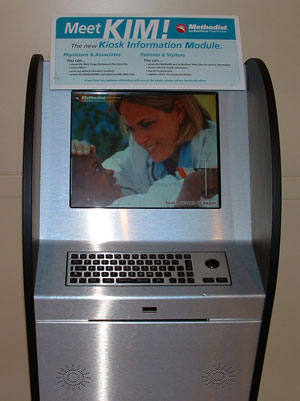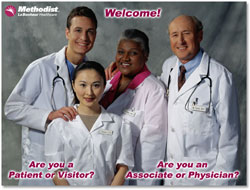Article
See me, touch me, heal me
Healthcare professionals are exploring ways in which kiosks can make their lives easier and their work more effective - by handling routine tasks and freeing up valuable time to focus on the tougher problems. And the machines offer big benefits to patients, as well.
April 27, 2005 by James Bickers — Editor, Networld Alliance
If you were to believe television's portrayal of the world of hospitals and healthcare, you'd think it was pure adrenaline, with life-or-death decisions made every few seconds, panicked shouts for help, and one tension-filled moment of real human drama after another.
Talk to anyone who actually works in healthcare, though, and you'll learn that hospitals are virtually never as exciting as depicted in such shows. In the real world, healthcare professionals are much more likely to deal with reams of paperwork and endless customer inquiries than, say, an armed assailant demanding the last pint of Type O blood.
Given the repetitive nature of much of the work these professionals spend their time on, self-service applications offer a world of potential.
"Although I am not aware of any official, specific market research, we see every day a groundswell of interest by healthcare providers," said Larry Mahar, executive vice president for Cypress, Calif.-based TouchVision Corp. "One of the major hospital information system software vendors told me that self-service patient registration was the number-one request from visitors to their exhibit booth at the HIMSS show in Dallas."
Checking in and finding your way
A number of different self-service applications are proving useful in the hospital setting. Tim Kearns, director of marketing for Portsmouth, R.I.-based MontegoNet, said that he sees potential in wayfinding and building directories, Internet access in waiting rooms, and kiosks that dispense health and patient information.
St. Clair Interactive Communications, Inc.
|
"And those are just visitor-focused applications," he added. "We've also seen increased interest from human resource departments, looking for self-service benefit kiosks for their employees, many of whom don't have regular access to a desktop PC."
MontegoNet recently helped build such a system for Methodist Healthcare, which operates seven hospitals and numerous clinics in Arkansas, Tennessee and Mississippi. According to Methodist's Web development supervisor Katherine Brown, the kiosks deployed in the first phase offer benefits to both patients and staff.
"For our associates, we have password-protected access to our Intranet and benefits information," she said. "This is important because we have some associates that do not have access to a PC."
Patients using the kiosk are allowed access to the organization's Web site. According to Brown, the next phase of the project will involve wayfinding, both within the building and directions to other facilities. "This is especially important in our larger facilities such as Methodist University Hospital," she said. "We are also planning to add concierge information about special services at our hospitals and in the surrounding areas."
 |
MontegoNet's kiosk for Methodist Healthcare serves both patient and physician. |
According to Brown, there was some initial hesitation to use the devices, simply owing to their newness - and, she said, "Some people initially thought they were ATMs." But today she sees them in use by both staff and patients.
A foot in the door
Mahar said that TouchVision has been installing kiosks in the healthcare environment for three years. He said that the easiest applications to sell to hospitals have been wayfinding, followed by general patient information systems, patient education and physician referral.
"The more difficult, yet more valuable, solutions are those that require integration with existing hospital information and/or clinical back-office systems," he said. "This is also the area where we are seeing the greatest interest and growth potential." Possible applications in this category include patient self-registration, check-in, health screening, appointment setting and risk assessment.
"These applications are more difficult for two reasons," he added. "First, there are a large number of back-office systems, many of which are technically difficult to interface with. Second, these systems require a change in the operating procedures of the hospitals and need to deal with customer resistance to change."
 |
The interface for Methodist Healthcare's kiosks |
According to Kearns, applications that interface with some of that existing data can be the easiest to deploy. In the case of their Methodist Healthcare system, the organization's Web content is repurposed for kiosk use. "If a hospital has existing health information modules or videos, making them available via kiosk is also relatively easy," he added.
He feels that one of the best kiosks a hospital can deploy is a building directory. "(They) generally require a bit more effort, as they would be customized to each hospital's needs, but they are among the most beneficial kiosks, as they're often the first thing that greets a visitor," he said.
Hygiene and privacy
Opinions differ when it comes to the question of cleanliness: Won't patient kiosks just be another way to facilitate the exchange of germs and illness between sick people?
"I don't believe this is a serious issue," Mahar said. "For the most part, the self-service systems are replacing a manual system which often includes a pen and a clipboard. Generally, non-porous touchscreen glass is more sanitary than a clipboard sitting in your lap with a pen attached to a string. Everything the patient comes in contact with in the hospital setting is surrounded by germs and sickness. There is nothing inherently less sanitary about a kiosk that should preclude its use."
Even so, Mahar said his company is working to minimize the amount of contact the patient has with the touchscreen, exploring options like RFID and smart cards.
R. Douglas McPheters, on the other hand, would like to see hospitals explore a touchless option. His company, HoloTouch, Inc., manufactures a technology that projects a keyboard, menu or other interface in mid-air; the user simply "touches" the space to control the application. In the case of HoloTouch, the interface is not only used for customer-facing devices, but also in the operating room. (Read more about touchless interfaces in "Reach out and touch Â… nothing?")
"My first choice would be a simple, touchless kiosk to allow out-patients to smoothly perform basic functions such as making insurance co-pays, purchasing parking passes, etc." McPheters said. "With that in place, the hospital and patients could save discomfort and money wasted on curing the secondary infections and diseases transmitted by tactile interfaces."
|
Kearns, for his part, offered a simpler answer.
"Hygiene is certainly a concern, but one with an easy solution - regular cleaning with any anti-bacterial surface cleaner," he said.
Kearns added that privacy should be top-of-mind when developing an application involving healthcare data. If patients are going to be viewing their medical records on a device located in a public space, steps must be taken to make sure that data is visible only to the user. This can involve privacy filters, as well as creative positioning of the device itself.
"We also add proximity sensors to the kiosks, which automatically detect when a kiosk user walks away," he added. "This in turn will instantly log a user out of whatever application they were in, and will erase the computer's cache."
Helping both parties
According to Mahar, self-service in the healthcare setting offers benefits to everyone involved. Patients get less hassle when it comes to administrative chores, and have access to fresher information when they need it. Providers lower their staff expenses, reduce errors, speed insurance processing, and reduce their risk.
In Kearns' view, it is the organization that reaps the biggest rewards.
"Kiosks take care of many routine information requests, allowing hospital staff to focus on more complex issues and provide better customer service," he said. "With healthcare providers facing increased competition, many are finding customer service to be a key differentiator, and kiosks can help make the customer experience more pleasant and productive. At the same time, HR kiosks help hospitals better address the needs of their internal customers, their employees."














